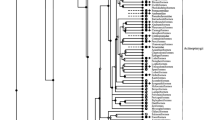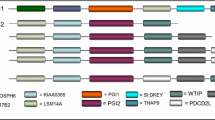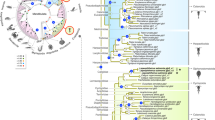Abstract.
To know whether genes involved in cell–cell communication typical of multicellular animals dramatically increased in concert with the Cambrian explosion, the rapid evolutionary burst in the major groups of animals, and whether these genes exist in the sponge lacking cell cohesiveness and coordination typical of eumetazoans, we have carried out cloning of the G-protein α subunit (Gα) and the protein tyrosine kinase (PTK) cDNAs from Ephydatia fluviatilis (freshwater sponge) and Hydra magnipapillata strain 105 (hydra). We obtained 13 Gα and 20 PTK cDNAs. Generally animal gene families diverged first by gene duplication (subtype duplication) that gave rise to diverse subtypes with different primary functions, followed by further gene duplication in the same subtype (isoform duplication) that gave rise to isoform genes with virtually identical function. Phylogenetic trees of Gα and PTK families including cDNAs from sponge and hydra revealed that most of the present-day subtypes had been established in the very early evolution of animals before the parazoan–eumetazoan split, the earliest branching among the extant animal phyla, by extensive subtype duplication: for PTK and Gα families, 23 and 9 subtype duplications were observed in the early stage before the parazoan–eumetazoan split, respectively, and after that split, only 2 and 1 subtype duplications were found, respectively. After the separation from arthropods, vertebrates underwent frequent isoform duplications before the fish–tetrapod split. Furthermore, rapid amino acid changes appear to have occurred in concert with the extensive subtype duplication and isoform duplication. Thus the pattern of gene diversification during animal evolution might be characterized by bursts of gene duplication interrupted by considerably long periods of silence, instead of proceeding gradually, and there might be no direct link between the Cambrian explosion and the extensive gene duplication that generated diverse functions (subtypes) of these families.
Similar content being viewed by others
Author information
Authors and Affiliations
Additional information
Received: 4 November 1998 / Accepted: 17 November 1998
Rights and permissions
About this article
Cite this article
Suga, H., Koyanagi, M., Hoshiyama, D. et al. Extensive Gene Duplication in the Early Evolution of Animals Before the Parazoan–Eumetazoan Split Demonstrated by G Proteins and Protein Tyrosine Kinases from Sponge and Hydra. J Mol Evol 48, 646–653 (1999). https://doi.org/10.1007/PL00006508
Issue Date:
DOI: https://doi.org/10.1007/PL00006508




